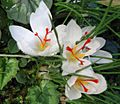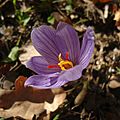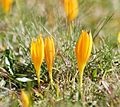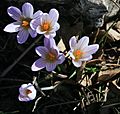Crocus facts for kids
Quick facts for kids Crocus |
|
|---|---|
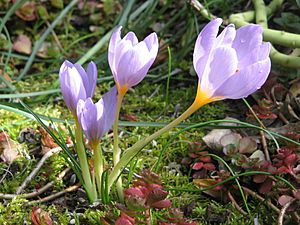 |
|
| Crocus longiflorus | |
| Scientific classification | |
| Kingdom: | |
| (unranked): | |
| (unranked): | |
| Order: | |
| Family: | |
| Subfamily: |
Crocoideae
|
| Genus: |
Crocus
|
| Type species | |
| Crocus sativus L.
|
|
| Species | |
|
See text. |
|
Crocus plants are a type of beautiful flowering plant. They belong to the iris family. There are about 80 different kinds, or species, of crocuses. These plants are perennials, which means they live for more than two years. They grow from a special underground stem called a corm. Many people grow crocuses in their gardens. Their lovely flowers can bloom in autumn, winter, or spring.
Crocuses naturally grow in many places. You can find them in woodlands, scrub, and meadows. They grow from sea level up to high mountain areas. Their native homes include central and southern Europe, North Africa, and the Middle East. They also grow on the islands of the Aegean and across Central Asia to western China.
Contents
What is a Crocus?
A crocus is a small plant known for its cup-shaped flowers. These flowers often have bright colors. They can be purple, yellow, white, or striped. Crocuses are one of the first flowers to appear in spring. Some types even bloom in autumn or winter. This makes them special garden plants.
Growing from a Corm
Crocus plants grow from a corm. A corm is like a bulb, but it's actually a swollen stem. It stores food for the plant. This stored food helps the crocus survive winter. It also helps it grow new flowers and leaves each year. When you plant a crocus, you plant its corm in the ground.
Where Crocuses Live
Crocuses are found all over the world. They grow naturally in many different habitats. These include forests, open fields, and even rocky mountain slopes. They are very tough plants. They can handle cold weather and even snow. This is why you often see them pushing through snow in early spring.
Types of Crocus Plants
There are many different species of crocuses. Each one has its own unique features. Some are tiny and delicate. Others have larger, more showy flowers. They also bloom at different times of the year.
Spring-Flowering Crocuses
Most crocuses that people know bloom in the spring. These are often planted in lawns or flower beds. They create a beautiful carpet of color. Popular spring types include the Dutch Crocus. These are often purple, white, or yellow. They are a sign that winter is ending.
Autumn-Flowering Crocuses
Some crocuses bloom in the fall. These are less common in gardens. They can be a nice surprise when other flowers are fading. One famous autumn-flowering crocus is the Saffron Crocus (Crocus sativus). This plant is very important.
The Saffron Crocus
The Saffron Crocus is special because it gives us saffron. Saffron is a valuable spice. It comes from the red parts inside the crocus flower. These parts are called stigmas. Each flower only has a few stigmas. This is why saffron is so expensive. It takes many flowers to make a small amount of spice.
People have used saffron for thousands of years. It adds a unique flavor and color to food. It's also been used as a dye and in medicines. The history of saffron goes back to ancient times. There are even old paintings showing people gathering saffron.
Winter-Flowering Crocuses
A few types of crocuses bloom in the middle of winter. These are very hardy plants. They can bring color to your garden when most other plants are dormant. They show that even in the coldest months, life can still bloom.
Crocuses in History and Culture
Crocuses have been important to humans for a long time. They appear in ancient art and writings. Their beauty and usefulness have made them special.
Ancient Uses
As mentioned, saffron from the Saffron Crocus was used long ago. Ancient civilizations valued it highly. It was used in cooking, perfumes, and medicines. It was even used as a dye for clothes. This shows how important plants like crocuses were to early societies.
Crocuses in Gardens
Today, crocuses are popular garden plants. They are easy to grow and care for. They add early color to gardens. Many people plant them under trees or in grassy areas. They can also be grown in pots. Their cheerful flowers are a welcome sight after winter.
Images for kids
See also
 In Spanish: Crocus para niños
In Spanish: Crocus para niños
















